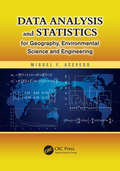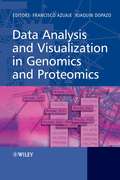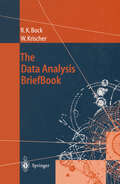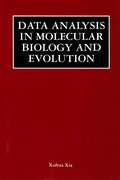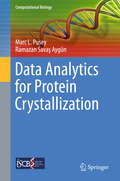- Table View
- List View
Data Analysis and Statistics for Geography, Environmental Science, and Engineering
by Miguel F. AcevedoProviding a solid foundation for twenty-first-century scientists and engineers, Data Analysis and Statistics for Geography, Environmental Science, and Engineering guides readers in learning quantitative methodology, including how to implement data analysis methods using open-source software. Given the importance of interdisciplinary work in sustain
Data Analysis and Visualization in Genomics and Proteomics
by Francisco Azuaje Joaquín DopazoData Analysis and Visualization in Genomics and Proteomics is the first book addressing integrative data analysis and visualization in this field. It addresses important techniques for the interpretation of data originating from multiple sources, encoded in different formats or protocols, and processed by multiple systems. One of the first systematic overviews of the problem of biological data integration using computational approaches This book provides scientists and students with the basis for the development and application of integrative computational methods to analyse biological data on a systemic scale Places emphasis on the processing of multiple data and knowledge resources, and the combination of different models and systems
The Data Analysis BriefBook (Accelerator Physics)
by Rudolf K. Bock Werner KrischerThis BriefBook is a much extended glossary or a much condensed handbook, depending on the way one looks at it. In encyclopedic format, it covers subjects in statistics, computing, analysis, and related fields, resulting in a book that is both an introduction and a reference for scientists and engineers, especially experimental physicists dealing with data analysis.
Data Analysis for Chemistry: An Introductory Guide for Students and Laboratory Scientists
by D. Brynn Hibbert J. Justin GoodingChemical data analysis, with aspects of metrology in chemistry and chemometrics, is an evolving discipline where new and better ways of doing things are constantly being developed. This book makes data analysis simple by demystifying the language and whenever possible giving unambiguous ways of doing things. Based on author D. Brynn Hibberts lectures on data analysis to undergraduates and graduate students, Data Analysis for Chemistry covers topics including measurements, means and confidence intervals, hypothesis testing, analysis of variance, and calibration models. The end result is a compromise between recipes of how to perform different aspects of data analysis, and basic information on the background principles behind the recipes to be performed. An entry level book targeted at learning and teaching undergraduate data analysis, Data Analysis for Chemistry makes it easy for readers to find the information they are seeking to perform the data analysis they think they need.
Data Analysis for Direct Numerical Simulations of Turbulent Combustion: From Equation-Based Analysis to Machine Learning
by Heinz Pitsch Antonio AttiliThis book presents methodologies for analysing large data sets produced by the direct numerical simulation (DNS) of turbulence and combustion. It describes the development of models that can be used to analyse large eddy simulations, and highlights both the most common techniques and newly emerging ones. The chapters, written by internationally respected experts, invite readers to consider DNS of turbulence and combustion from a formal, data-driven standpoint, rather than one led by experience and intuition. This perspective allows readers to recognise the shortcomings of existing models, with the ultimate goal of quantifying and reducing model-based uncertainty. In addition, recent advances in machine learning and statistical inferences offer new insights on the interpretation of DNS data. The book will especially benefit graduate-level students and researchers in mechanical and aerospace engineering, e.g. those with an interest in general fluid mechanics, applied mathematics, and the environmental and atmospheric sciences.
Data Analysis for Scientists and Engineers (PDF)
by Edward L. RobinsonData Analysis for Scientists and Engineers is a modern, graduate-level text on data analysis techniques for physical science and engineering students as well as working scientists and engineers. Edward Robinson emphasizes the principles behind various techniques so that practitioners can adapt them to their own problems, or develop new techniques when necessary. Robinson divides the book into three sections. The first section covers basic concepts in probability and includes a chapter on Monte Carlo methods with an extended discussion of Markov chain Monte Carlo sampling. The second section introduces statistics and then develops tools for fitting models to data, comparing and contrasting techniques from both frequentist and Bayesian perspectives. The final section is devoted to methods for analyzing sequences of data, such as correlation functions, periodograms, and image reconstruction. While it goes beyond elementary statistics, the text is self-contained and accessible to readers from a wide variety of backgrounds. Specialized mathematical topics are included in an appendix. Based on a graduate course on data analysis that the author has taught for many years, and couched in the looser, workaday language of scientists and engineers who wrestle directly with data, this book is ideal for courses on data analysis and a valuable resource for students, instructors, and practitioners in the physical sciences and engineering. In-depth discussion of data analysis for scientists and engineers Coverage of both frequentist and Bayesian approaches to data analysis Extensive look at analysis techniques for time-series data and images Detailed exploration of linear and nonlinear modeling of data Emphasis on error analysis Instructor's manual (available only to professors)
Data Analysis for the Life Sciences with R
by Rafael A. Irizarry Michael I. LoveThis book covers several of the statistical concepts and data analytic skills needed to succeed in data-driven life science research. The authors proceed from relatively basic concepts related to computed p-values to advanced topics related to analyzing highthroughput data. They include the R code that performs this analysis and connect the lines of code to the statistical and mathematical concepts explained.
Data Analysis for the Life Sciences with R
by Rafael A. Irizarry Michael I. LoveThis book covers several of the statistical concepts and data analytic skills needed to succeed in data-driven life science research. The authors proceed from relatively basic concepts related to computed p-values to advanced topics related to analyzing highthroughput data. They include the R code that performs this analysis and connect the lines of code to the statistical and mathematical concepts explained.
Data Analysis in Astronomy: Proceedings Of The 5th Workshop Ettore Majorana Center For Scientific Culture, Erice, Italy, 27 October-3 November 1996 (pdf) (Ettore Majorana International Science Series #24)
by V. Di Gesù L. Scarsi P. Crane J. H. Friedman S. LevialdiData Analysis in Astronomy II (Polymer Science and Technology Series #21)
by V. Di Gesù L. ScarsiThe II international workshop on "Data Analysis in Astronomy" was intended to provide an overview on the state of the art and the trend in data analy sis and image processing in the context of their applications in Astronomy. The need for the organization of a second workshop in this subject derived from the steady. growing and development in the field and from the increasing cross-interaction between methods, technology and applications in Astronomy. The book is organized in four main sections: - Data Analysis Methodologies - Data Handling and Systems dedicated to Large Experiments - Parallel Processing - New Developments The topics which have been selected cover some of the main fields in data analysis in Astronomy. Methods that provide a major contribution to the physical interpretation of the data have been considered. Attention has been devoted to the description of the data analysis and handling organization in very large experiments. A review of the current major satellite and ground based experiments has been included. At the end of the book the following 'Panel Discussions' are included: - Data Analysis Trend in Optical and Radio Astronomy - Data Analysis Trend in X and Gamma Astronomy - Problems and Solutions in the Design of Very Large Experiments - Trend on Parallel Processing Algorithms These contributions in a sense summarize the 'live' reaction of the audience to the various topics.
Data Analysis in Astronomy III (Ettore Majorana International Science Series #40)
by V. Di Gesù L. Scarsi R. Buccheri P. Crane M. C. Maccarone H. U. ZimmermanIn the book are reported the main results presented at the Third International Workshop on Data Analysis in Astronomy, held at the EUore Majorana Center for Scientific Culture, Erice, Sicily, Italy, on June 20-27,1988. The Workshop was the natural evolution of the two previous ones. The main goal of the first edition (Erice 1984) was to start a scientific interaction between Astronomers and Computer Scientists. Aim of the second (Erice 1986) was to look at the progress in data analysis methods and dedicated hardware technology. Data analysis problems become harder whenever the data are poor in statistics or the signal is weak and embedded in structured background. Experiments collecting data of such a nature require new and non-standard methodologies. Possibilistic approaches could be merged with the statistical ones, in order to formalize all the knowledge used by the scientists to reach conclusions. Moreover, the last decade has been characterized by very fast developments of Intelligent Systems for data analysis (knowledge based systems, ... ) that would be useful to support astronomers in complex decision making. For these reasons, the last edition of the workshop was intended to provide an overview on the state of the art in the data analysis methodologies and tools in the new frontieres of the astrophysics (y-astronomy, neutrino astronomy, gravitational waves, background radiation and extreme cosmic ray energy spectrum). The book is organized in two sections: - Data analysis methods and tools, - New frontieres in astronomy.
Data Analysis in Astronomy IV (Ettore Majorana International Science Series #59)
by R. Buccheri P. Crane Vito Di Gesù M. C. Maccarone L. Scarsi H. U. ZimmermannIn this book are reported the main results presented at the "Fourth International Workshop on Data Analysis in Astronomy", held at the Ettore Majorana Center for Scientific Culture, Erice, Sicily, Italy, on April 12-19, 1991. The Workshop was preceded by three workshops on the same subject held in Erice in 1984, 1986 and 1988. The frrst workshop (Erice 1984) was dominated by presentations of "Systems for Data Analysis"; the main systems proposed were MIDAS, AlPS, RIAIP, and SAIA. Methodologies and image analysis topics were also presented with the emphasis on cluster analysis, multivariate analysis, bootstrap methods, time analysis, periodicity, 2D photometry, spectrometry, and data compression. A general presentation on "Parallel Processing" was made which encompassed new architectures, data structures and languages. The second workshop (Erice 1986) reviewed the "Data Handling Systems" planned for large major satellites and ground experiments (VLA, HST, ROSAT, COMPASS-COMPTEL). Data analysis methods applied to physical interpretation were mainly considered (cluster photometry, astronomical optical data compression, cluster analysis for pulsar light curves, coded aperture imaging). New parallel and vectorial machines were presented (cellular machines, PAPIA-machine, MPP-machine, vector computers in astronomy). Contributions in the field of artificial intelligence and planned applications to astronomy were also considered (expert systems, artificial intelligence in computer vision).
Data Analysis in Cosmology (Lecture Notes in Physics #665)
by Vicent J. Martinez Enn Saar Enrique Martinez Gonzales Maria Jesus Pons-BorderiaThe amount of cosmological data has dramatically increased in the past decades due to an unprecedented development of telescopes, detectors and satellites. Efficiently handling and analysing new data of the order of terabytes per day requires not only computer power to be processed but also the development of sophisticated algorithms and pipelines.Aiming at students and researchers the lecture notes in this volume explain in pedagogical manner the best techniques used to extract information from cosmological data, as well as reliable methods that should help us improve our view of the universe.
Data Analysis in High Energy Physics: A Practical Guide to Statistical Methods
by Olaf BehnkeThis practical guide covers the essential tasks in statistical data analysis encountered in high energy physics and provides comprehensive advice for typical questions and problems. The basic methods for inferring results from data are presented as well as tools for advanced tasks such as improving the signal-to-background ratio, correcting detector effects, determining systematics and many others. Concrete applications are discussed in analysis walkthroughs. Each chapter is supplemented by numerous examples and exercises and by a list of literature and relevant links. The book targets a broad readership at all career levels - from students to senior researchers. An accompanying website provides more algorithms as well as up-to-date information and links. * Free solutions manual available for lecturers at www.wiley-vch.de/supplements/
Data Analysis in High Energy Physics: A Practical Guide to Statistical Methods
by Olaf Behnke Kevin Kröninger Grégory Schott Thomas Schrner-SadeniusThis practical guide covers the essential tasks in statistical data analysis encountered in high energy physics and provides comprehensive advice for typical questions and problems. The basic methods for inferring results from data are presented as well as tools for advanced tasks such as improving the signal-to-background ratio, correcting detector effects, determining systematics and many others. Concrete applications are discussed in analysis walkthroughs. Each chapter is supplemented by numerous examples and exercises and by a list of literature and relevant links. The book targets a broad readership at all career levels - from students to senior researchers. An accompanying website provides more algorithms as well as up-to-date information and links. * Free solutions manual available for lecturers at www.wiley-vch.de/supplements/
Data Analysis in Molecular Biology and Evolution
by Xuhua XiaData Analysis in Molecular Biology and Evolution introduces biologists to DAMBE, a proprietary, user-friendly computer program for molecular data analysis. The unique combination of this book and software will allow biologists not only to understand the rationale behind a variety of computational tools in molecular biology and evolution, but also to gain instant access to these tools for use in their laboratories. Data Analysis in Molecular Biology and Evolution serves as an excellent resource for advanced level undergraduates or graduates as well as for professionals working in the field.
Data Analysis in Vegetation Ecology
by Otto WildiEvolving from years of teaching experience by one of the top experts in vegetation ecology, Data Analysis in Vegetation Ecology aims to explain the background and basics of mathematical (mainly multivariate) analysis of vegetation data. The book lays out the basic operations involved in the analysis, the underlying hypotheses, aims and points of views. It conveys the message that each step in the calculations has a specific, straightforward meaning and that patterns and processes known by ecologists often find their counterpart in mathematical operations and functions. The first chapters introduce the elementary concepts and operations and relate them to real-world phenomena and problems. Later chapters concentrate on combinations of methods to reveal surprising features in data sets. Showing how to find patterns in time series, how to generate simple dynamic models, how to reveal spatial patterns and related occurrence probability maps.
Data Analysis in Vegetation Ecology
by Otto WildiEvolving from years of teaching experience by one of the top experts in vegetation ecology, Data Analysis in Vegetation Ecology aims to explain the background and basics of mathematical (mainly multivariate) analysis of vegetation data. The book lays out the basic operations involved in the analysis, the underlying hypotheses, aims and points of views. It conveys the message that each step in the calculations has a specific, straightforward meaning and that patterns and processes known by ecologists often find their counterpart in mathematical operations and functions. The first chapters introduce the elementary concepts and operations and relate them to real-world phenomena and problems. Later chapters concentrate on combinations of methods to reveal surprising features in data sets. Showing how to find patterns in time series, how to generate simple dynamic models, how to reveal spatial patterns and related occurrence probability maps.
Data Analysis in Vegetation Ecology
by Otto WildiThe 3rd edition of this popular textbook introduces the reader to the investigation of vegetation systems with an emphasis on data analysis. The book succinctly illustrates the various paths leading to high quality data suitable for pattern recognition, pattern testing, static and dynamic modelling and model testing including spatial and temporal aspects of ecosystems. Step-by-step introductions using small examples lead to more demanding approaches illustrated by real world examples aimed at explaining interpretations. All data sets and examples described in the book are available online and are written using the freely available statistical package R. This book will be of particular value to beginning graduate students and postdoctoral researchers of vegetation ecology, ecological data analysis, and ecological modelling, and experienced researchers needing a guide to new methods. A completely revised and updated edition of this popular introduction to data analysis in vegetation ecology. Includes practical step-by-step examples using the freely available statistical package R. Complex concepts and operations are explained using clear illustrations and case studies relating to real world phenomena. Emphasizes method selection rather than just giving a set of recipes.
Data Analysis, Machine Learning and Knowledge Discovery (Studies in Classification, Data Analysis, and Knowledge Organization)
by Myra Spiliopoulou Lars Schmidt-Thieme Ruth JanningData analysis, machine learning and knowledge discovery are research areas at the intersection of computer science, artificial intelligence, mathematics and statistics. They cover general methods and techniques that can be applied to a vast set of applications such as web and text mining, marketing, medicine, bioinformatics and business intelligence. This volume contains the revised versions of selected papers in the field of data analysis, machine learning and knowledge discovery presented during the 36th annual conference of the German Classification Society (GfKl). The conference was held at the University of Hildesheim (Germany) in August 2012.
Data Analytics: Proceedings Of 4th Conference On Sustainable Urban Mobility (csum2018), 24 - 25 May, Skiathos Island, Greece (Advances In Intelligent Systems and Computing #879)
by Eftihia G. Nathanail Ioannis D. KarakikesThis book aims at showing how big data sources and data analytics can play an important role in sustainable mobility. It is especially intended to provide academicians, researchers, practitioners and decision makers with a snapshot of methods that can be effectively used to improve urban mobility. The different chapters, which report on contributions presented at the 4th Conference on Sustainable Urban Mobility, held on May 24-25, 2018, in Skiathos Island, Greece, cover different thematic areas, such as social networks and traveler behavior, applications of big data technologies in transportation and analytics, transport infrastructure and traffic management, transportation modeling, vehicle emissions and environmental impacts, public transport and demand responsive systems, intermodal interchanges, smart city logistics systems, data security and associated legal aspects. They show in particular how to apply big data in improving urban mobility, discuss important challenges in developing and implementing analytics methods and provide the reader with an up-to-date review of the most representative research on data management techniques for enabling sustainable urban mobility
Data Analytics for Drilling Engineering: Theory, Algorithms, Experiments, Software (Information Fusion and Data Science)
by Qilong XueThis book presents the signal processing and data mining challenges encountered in drilling engineering, and describes the methods used to overcome them. In drilling engineering, many signal processing technologies are required to solve practical problems, such as downhole information transmission, spatial attitude of drillstring, drillstring dynamics, seismic activity while drilling, among others. This title attempts to bridge the gap between the signal processing and data mining and oil and gas drilling engineering communities. There is an urgent need to summarize signal processing and data mining issues in drilling engineering so that practitioners in these fields can understand each other in order to enhance oil and gas drilling functions. In summary, this book shows the importance of signal processing and data mining to researchers and professional drilling engineers and open up a new area of application for signal processing and data mining scientists.
Data Analytics for Process Engineers: Prediction, Control and Optimization (Synthesis Lectures on Mechanical Engineering)
by Daniela Galatro Stephen DaweThis book provides an industry-oriented data analytics approach for process engineers, including data acquisition methods and sources, exploratory data analysis and sensitivity analysis, data-based modelling for prediction, data-based modelling for monitoring and control, and data-based optimization of processes. While many of the current data analytics books target business-related problems, the rationale for this book is a specific need to understand and select applicable data analytics approaches pragmatically to analyze process engineering–related problems; this tailored solution for engineers gets amalgamated with governing equations, and in several cases, with the physical understanding of the phenomenon being analyzed. We also consider this book strategically conceived to help map Education 4.0 with Industry 4.0 since it can support undergraduate and graduate students to gain valuable and applicable data analytics stills that can be further used in their workplace. Moreover, it can be used as a reference book for professionals, a quick reference to data analytics tools that can facilitate and/or optimize their process engineering tasks.
Data Analytics for Protein Crystallization (Computational Biology #25)
by Marc L. Pusey Ramazan Savaş AygünThis unique text/reference presents an overview of the computational aspects of protein crystallization, describing how to build robotic high-throughput and crystallization analysis systems. The coverage encompasses the complete data analysis cycle, including the set-up of screens by analyzing prior crystallization trials, the classification of crystallization trial images by effective feature extraction, the analysis of crystal growth in time series images, the segmentation of crystal regions in images, the application of focal stacking methods for crystallization images, and the visualization of trials.Topics and features: describes the fundamentals of protein crystallization, and the scoring and categorization of crystallization image trials; introduces a selection of computational methods for protein crystallization screening, and the hardware and software architecture for a basic high-throughput system; presents an overview of the image features used in protein crystallization classification, and a spatio-temporal analysis of protein crystal growth; examines focal stacking techniques to avoid blurred crystallization images, and different thresholding methods for binarization or segmentation; discusses visualization methods and software for protein crystallization analysis, and reviews alternative methods to X-ray diffraction for obtaining structural information; provides an overview of the current challenges and potential future trends in protein crystallization.This interdisciplinary work serves as an essential reference on the computational and data analytics components of protein crystallization for the structural biology community, in addition to computer scientists wishing to enter the field of protein crystallization.
Data Analytics for Renewable Energy Integration: 4th ECML PKDD Workshop, DARE 2016, Riva del Garda, Italy, September 23, 2016, Revised Selected Papers (Lecture Notes in Computer Science #10097)
by Wei Lee Woon Zeyar Aung Oliver Kramer Stuart MadnickThis book constitutes revised selected papers from the 4th ECML PKDD Workshop on Data Analytics for Renewable Energy Integration, DARE 2016, held in Riva del Garda, Italy, in September 2016. The 11 papers presented in this volume were carefully reviewed and selected for inclusion in this book and handle topics such as time series forecasting, the detection of faults, cyber security, smart grid and smart cities, technology integration, demand response and many others.
